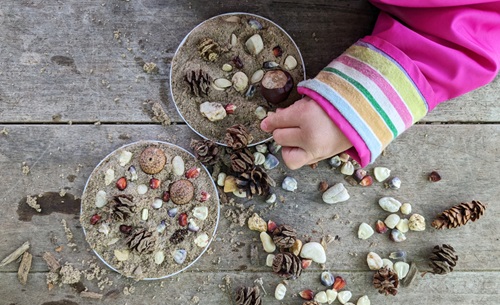Nature patterns with loose parts
| October 2021Autumn’s the time when natural loose parts are easy to find in your outdoor area, garden or local park. Take buckets or bags and fill them with conkers, acorns, beech nuts, the last flowers, coloured leaves, pine cones or pebbles. Allow plenty of time for finding and gathering as children discover shape, size, texture and colour. While they make patterns with the loose parts they’ve found, they’ll be sorting, counting, designing and discovering symmetry. It’s maths, art and science all at once.

Before you begin this activity: Your children may be familiar with the concept of patterns. But if not, spend time with them understanding patterns.
- Discuss: what is a pattern?
- Talk about repeated sequences.
- Identify patterns.
- Show them some examples of patterns.
Materials needed: buckets or containers, natural loose parts
Instructions:
Provide each child with a bucket, bag or container. Let children roam your outdoor area and collect lots of natural loose parts. Encourage children to collect several of each item to make patterns with.
1. Allow plenty of time for gathering, as children discover shape, colour, size and texture. You can turn this part into an on-the-go nature class if you like, talking about the seasonal changes and why leaves turn colours and trees drop their nuts and fruits.

2. Find a space for each child to make their patterns, ideally outdoors on a flat surface such as a lawn, paved area or under a tree. Children are best off spaced out, so they can work undisturbed. If you don’t have outdoor space, working on the floor or a table will do.

3. Then let the children get started with making patterns using the loose parts they’ve found. Some children will immediately have an idea of a design, while others may need a little encouragement. If necessary, give some starting pointers to help them begin, e.g. “Perhaps you could start in the middle and work your way out” or “Maybe you could start with your acorns and leaves making a pattern”, etc. Remember that some of the designs may be very simple, while others are more elaborate. Avoid interfering too much or arranging the objects yourself. After all, this should be discovery learning, and it’s the process not the result that matters!

4. Admire their work, and if possible, save for parents to have a look or take photos for children to bring home or display in your setting.

5. Repeat this activity, and you’ll see children’s ideas expand, patterns becoming more complex and intricate.
See a few more designs created by five-year-olds:








